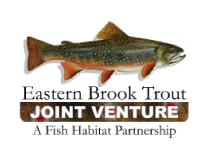EBTJV's Conservation Strategies
Range-wide Habitat Goals and Objectives
|
GOAL |
OBJECTIVE |
|
Increase the average size (km2) of wild Brook Trout patches, which is currently 19 km2 |
Increase the size (km2) of 30 wild Brook Trout patches by the year 2022. |
|
Restore wild Brook Trout to catchments where they were extirpated |
Establish wild Brook Trout in 15 extirpated catchments by the year 2022. |
|
Maintain the current number of wild Brook Trout patches (i.e. no net loss) |
Retain at least 6,022 allopatric wild Brook Trout patches (1.1) across the EBTJV geographic range by the year 2022.
Retain at least 3,838 sympatric wild Brook Trout patches (1.2, 1.3, and 1.4) across the EBTJV geographic range by the year 2022. |
|
Increase connectivity within and among wild Brook Trout catchments |
Complete Aquatic Organism Passage projects within 45 wild Brook Trout catchments by 2022. |
Conservation Goals
Conserve, enhance or restore wild Brook Trout populations that have been impacted by habitat modification, non-native species and other population level threats.
Encourage partnerships among management agencies and stakeholders to seek solutions to regional environmental and ecological threats.
Develop and implement outreach and educational programs to raise public awareness about the challenges that wild Brook Trout populations are facing.
Develop support for program implementation to perpetuate and restore wild Brook Trout populations throughout their historical eastern U.S. range.
Conservation Scales
Brook Trout conservation occurs at three scales, or levels:
Rage-wide: Conservation goals and habitat objectives are established at this scale in an effort to guide activities at the State scale.
State: States identify focal watersheds and determine the conservation actions that will contribute best to meeting range-wide habitat objectives.
Local: Local partners implement wild Brook Trout conservation projects that are congruent with the range-wide habitat objectives and input provided by their respective State.
Conservation Actions
Increase recreational fishing opportunities for wild Brook Trout
Conserve and expand habitats that support robust wild Brook Trout populations
Restore and reconnect suitable habitats adjacent to robust wild Brook Trout populations
Conserve genetic diversity of wild Brook Trout populations
Conserve unique wild Brook Trout life history strategies
(e.g., lacustrine populations, large river populations, and coastal populations)
Minimize threats to wild Brook Trout populations
(e.g., degraded water quality, non-native species, altered hydrologic regimes)
Examples of what can be done to achieve these actions include: restoring aquatic connectivity by removing small dams and replacing undersized culverts; mitigating acid mine drainage to improve water quality; executing strategies that eliminate competition from non-native species; and, planting native trees in riparian zones to provide shaded waters and stream bank stabilization.
View all of our conservation and business plans here.
See an infographic of our Conservation Strategy documents through the years.
Document Actions






